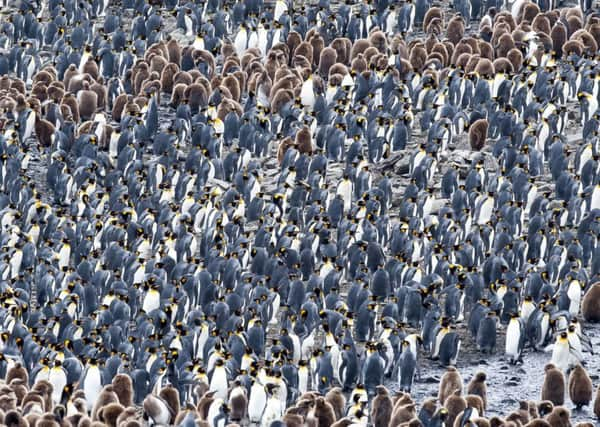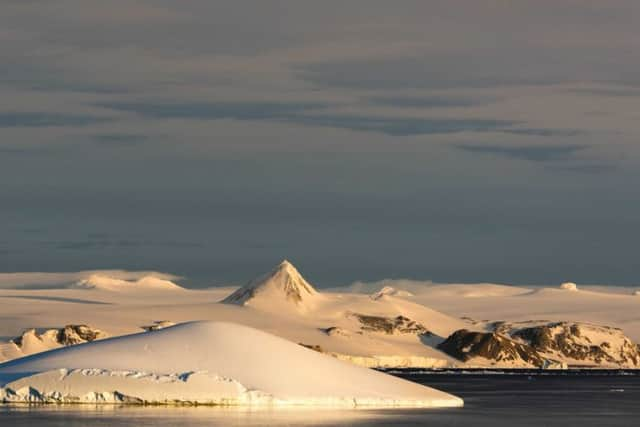Antarctica: Kings of the wild frontier


Ahead of me, 80,000 pairs of king penguins have formed a river of black and golden feathers, tumbling down the hillside at South Georgia’s Salisbury Plain. We’ve hiked for 40 minutes across muddy terrain to reach the colony, through thick tussocks littered with agitated fur seals and their marble-eyed pups, who inquisitively swivel heads 180 degrees to look up at you.
Home to only a handful of scientific researchers, South Georgia is one of the biggest marine protection areas in the world and a breeding ground for 30m seabirds. I’m one of the 7,000 privileged tourists visiting each year, stopping by as part of a 19-day voyage to Antarctica with One Ocean Expeditions.
Advertisement
Hide AdAdvertisement
Hide AdOur expedition ship, the Vavilov, is a Russian research vessel fitted with sensors on the hull to collect data during our journey, but with a bar, sauna and hot tub on board, we’re by no means roughing it.


The loose, subject-to-change itinerary for the next two and a half weeks will follow the footsteps of celebrated polar explorer Ernest Shackleton, whose Trans-Antarctic Endurance expedition was crushed by sea ice exactly 100 years ago. But as one guest whispers to me in hushed tones, “Let’s be honest – most of us are really here to see the penguins.”
We’re likely to encounter six species on our trip, all with their own amusing eccentricities, but one of the most entertaining has to be the spiky-haired rockhopper. Three-quarters of the world’s population can be found on the Falklands, an archipelago 300 miles east of southern Argentina, and the first stop on our trip.
One of the most scenic rookeries, shared with the elegant black-browed albatross, is at West Point Island. Couple Thies and Kicki, who have spent the last 25 years travelling the world in their 62-year-old yacht, Wanderer III, are the only residents on the island, spending days fixing fences and preparing afternoon tea for the 20 tourist ships that pass through in a season.
Advertisement
Hide AdAdvertisement
Hide AdAs she drives us across the island in her rusty 4x4, Swedish-born Kicki tells me: “Twenty years ago, we’d never have believed we would find a place like this beautiful. But it’s grown on us.” The following three days are spent at sea watching albatrosses, petrels and tiny prions riding on our tailwinds and darting through the crests of waves, until we reach the most nutrient-rich sector of the Antarctic Ocean, South Georgia. At one time, the waters here were full of humpback and blue whales, but a thriving whaling industry decimated the population in a matter of decades. Now, the derelict rusty stations are once again overrun by wildlife.
At sheltered harbour Grytviken, where there’s a small maritime museum and post office selling its own issues of stamps, I find kelp gulls perched on blubber ovens and penguins wandering through the rubble. A bulbous elephant seal slithers across Shackleton’s grave, set on the hillside, and lets out a snort from his salt-crusted nostrils.
We find more of the blubbery pinnipeds at Gold Harbour, a glorious snapshot of the wild chaos and community that shapes South Georgia. While the serious beachmasters may have long since departed (you’ll find them here in October/November), adolescent male elephant seals rear up to play fight, while opportunistic skuas try to pick off vulnerable chicks from a colony of king penguins, and orange-billed gentoos hurriedly go about their business. It all takes place against a dramatic backdrop of calving glaciers, deep blue sky and rolling surf.
As we leave South Georgia, we pass a mile-long tabular iceberg that’s taken several months to travel from our next destination, Antarctica. Eulogised by explorers with frosty white beards, it’s the coldest, windiest and driest continent on Earth; a hostile wilderness that belongs to no-one except, of course, the penguins.
Advertisement
Hide AdAdvertisement
Hide AdThe burning red light of dawn wakes me at 2.30am, as we enter the Antarctic Sound, an unspeakably beautiful stretch of water separating the Antarctic peninsula from nearby islands.
Later that day, we make our first continent landing at Brown Bluff, where jagged rocks jut out like a lower set of incisors. Cape petrels engulf our Zodiac dinghy as we head for the shore, where Adelies and gentoos are nesting. I pass the skeleton of an emperor – a penguin that’s near impossible to see, unless you’re extremely lucky or have £30K to spend on an expedition further into the continent – then I sit for more than an hour watching the penguins get down to the crafty business of stone stealing.
During our final landing, at Cuverville Island, a snowstorm sets in and a sharp wind tears through the rocks. Most people have returned to the Vavilov, but I sit with a 67-year-old woman, Christine, eking out our last precious moments with the penguins. “I’m old,” she sighs, while trying to film the scene with her compact camera. “In reality, I know I’ll never see this again.” But sad as it is to accept, that fleeting beauty is what makes Antarctica such an incomparably special place.
• Sarah Marshall was a guest of One Ocean Expeditions (www.oneoceanexpeditions.com) who offer 18 night/19 day voyages to Falklands, South Georgia and Antarctica from £12,695, departing October 23, Nov 22 and Dec 30.
Advertisement
Hide AdAdvertisement
Hide AdPrice includes accommodation and all meals onboard, plus Zodiac excursions and landings, ship transfers and foul weather gear.
KLM (www.klm.com) flies to Buenos Aires from £739 from London Heathrow, via Amsterdam, with various regional departures available.